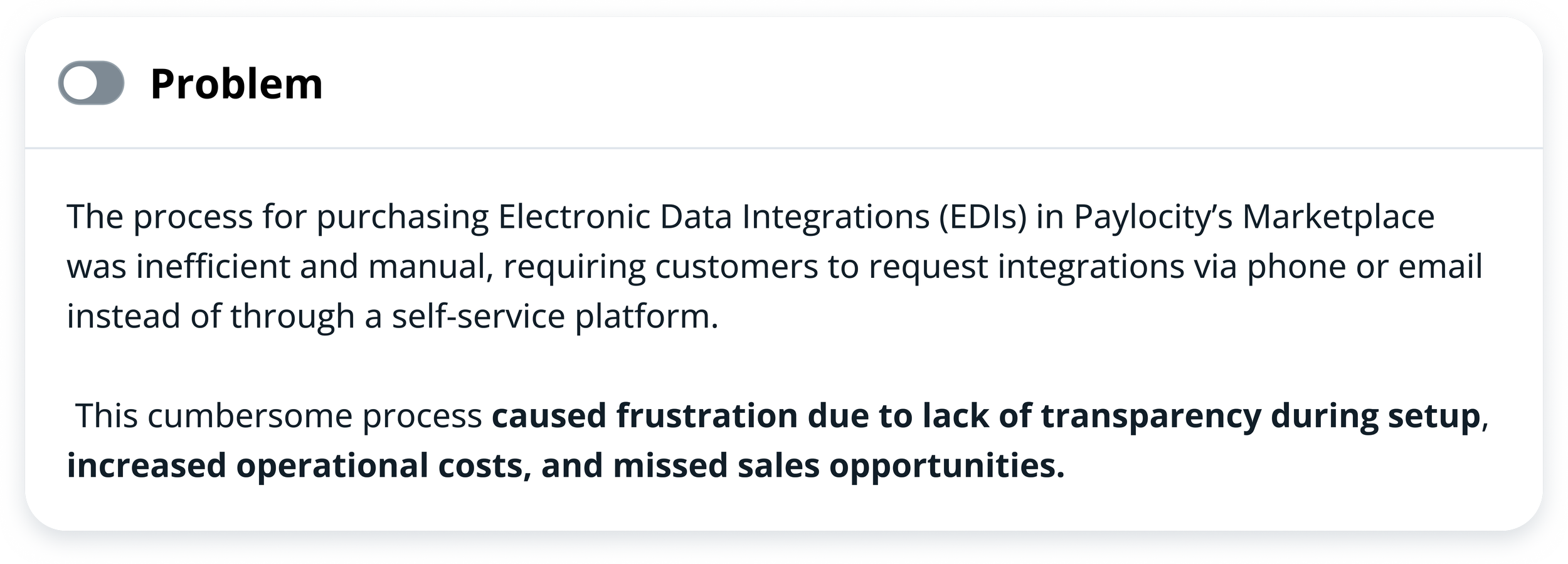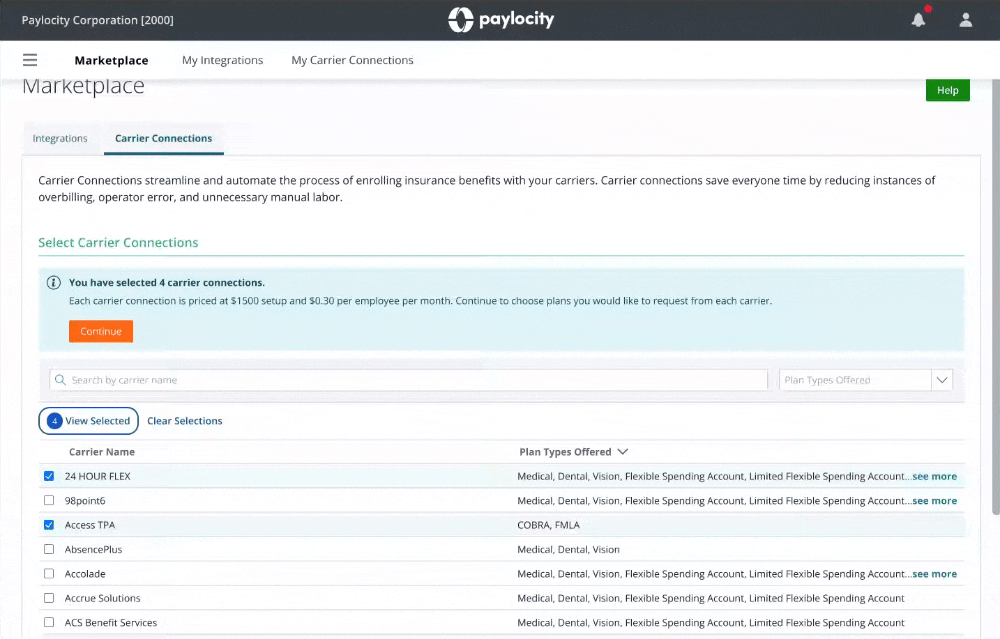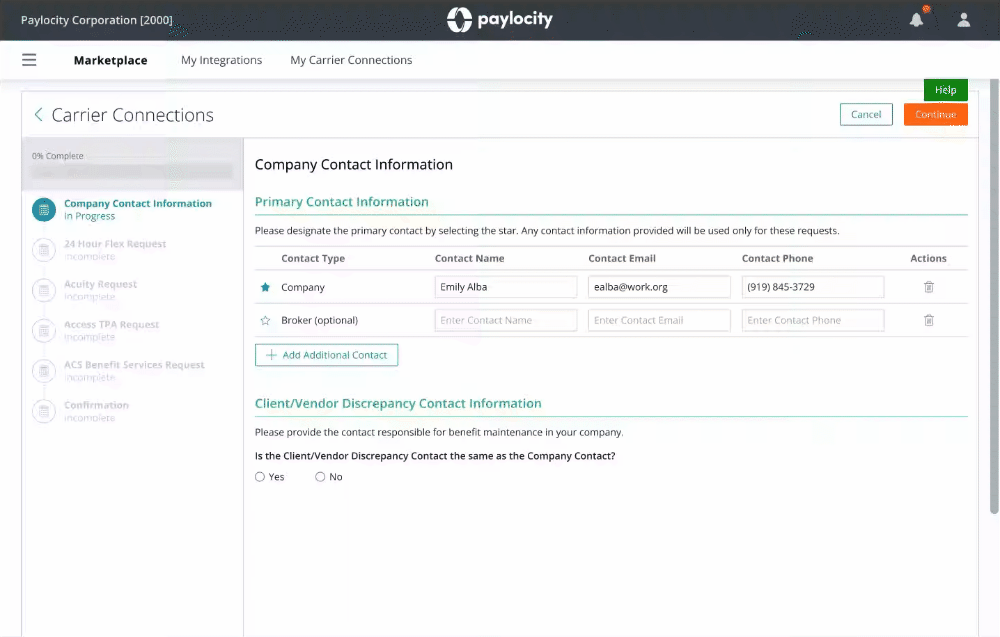
Introducing Electronic Data Integrations in the Marketplace
Role
Product Design Lead
Scope
Brand new product to Marketplace’s ecosystem of integrations
About The Project
Duration
4 months
Platform
Desktop
Context
Paylocity’s Marketplace is a B2B platform that enables businesses to discover and connect with third-party software providers, APIs, and other service providers to integrate their services and capabilities into their own products or applications.
For this project, I led the introduction of a new type of integration into our ecosystem known as Electronic Data Integrations (EDIs), designed to streamline the transfer of employees’ insurance information between systems. Our objective was to empower customers with an intuitive, self-service solution for initiating EDI setup, ensuring their employees' most up-to-date insurance elections were seamlessly transmitted to their benefits providers.
Project Overview
Team
1 Product Manager
4 Engineers
01 - context
What are Electronic Data Integrations (EDIs)?
Before introducing EDIs into the Marketplace, it was crucial to fully understand what they are and how they work.
To build this foundation, I conducted four internal interviews with our EDI specialists. These conversations led to three key insights:
EDIs are files that transfer employee data (employee demographic and benefit enrollment information) to benefit providers.
EDIs are requested by emailing your Benefits Account Manager an EDI request form (one per carrier requested).
On average, Administrators submit 3-4 requests per year.
02 - the problem
Now Here’s Where EDI Requests Break Down
The EDI Form itself
To submit an EDI request, filling out one form per carrier, one by one, can be time-consuming.

Solution Preview

03 - the challenge
We struggled to design an efficient way for clients to request EDI integrations through the Marketplace.
Although clients could fill out a generic request form, the process lacked structure, required offline follow-up, and failed to account for the complexity of EDI setup across different integration types—leading to dropped requests, confusion, and missed revenue opportunities.
04 - understanding the problem space
We documented key design decisions and edge cases.
Design Decision #1: What should we call EDIs and where should they live?
As we introduced this new product into the Marketplace, we needed to reassess the Information Architecture. In the HCM space, there’s often a gap between internal terminology and the language our clients use. A brief customer survey revealed that while we refer to them as EDIs, clients know them as “Carrier Connections.” We also learned that although EDIs are a type of integration, they function differently from our other offerings.
By conducting interviews, we identified that users instinctively turn to the Marketplace when looking to purchase anything. Based on this behavior, we made the strategic decision to place EDI purchasing within the Marketplace, ensuring discoverability and aligning with existing user habits.
Design Proposal #1:
We explored placing EDIs as (1) Creating a dedicated page accessible from the main navigation and directing users to it via a contextual callout, (2) Adding a dropdown menu that separates "Integrations" and "Carrier Connections" as distinct options, (3) Decoupling EDIs from the existing partner integrations catalog and implementing a tab-based interface to allow users to easily toggle between the two.
Design Decision #2: What design patterns best enable users to request their EDIs/Carrier Connections?
Design Proposal #2:
Providing customers with easily selecting (1) Smart recommendations tailored to the carriers they’re already contracted with, (2) a comprehensive directory of available EDIs, allowing them to proactively initiate connections with carriers not yet under contract, (3) Additional intelligent suggestions to help identify high-priority or commonly used carriers based on usage trends or industry relevance.
Ultimately, we decided to pursue option 2 - providing users will all possible EDI connections - since the backend did not fully support smart recommendations.
How do we surface unique contract details?
Each customer’s sales contract with Paylocity includes unique terms regarding EDIs. For instance, one client might receive three complimentary EDIs or Carrier Connections as part of their package, while others may receive more or fewer.
These contractual differences directly influence how pricing is applied. To create a transparent and seamless experience, it was critical that clients could easily identify which EDIs were covered under their contract and which would incur additional charges.
Pricing Modal Exploration

Our Final Designs
Customers will now be able to select multiple EDIs in a single request. Additionally, upon selection, we will surface customer-specific contract details, enabling them to make more informed purchasing decisions.
Our new solution streamlines the purchase experience by allowing customers to fill out a single form for multiple carriers, reducing form fatigue and eliminating redundancies.
Additionally, we’ve enhanced the form’s usability by making it more intuitive and incorporating updated guiding text for clarity and ease of completion.
Introduced ‘Carrier Connections’ in the Marketplace as its own tab.
With our new solution, customers gain pricing transparency, ensuring they understand the costs associated with their EDI requests. Historically, customers had no knowledge of pricing which led many questions to Support about invoices.
After completing the form, users will now see a 'success' page confirming that their submission has been sent to their Representative. They will also be directed to the 'My Carrier Connections' page, which serves as a standing record they can revisit at any time.

Results & Takeaways
Though quantitative metrics are not yet available, the qualitative insights are promising:
EDI Implementation teams are excited to be able to have a dedicated platform for the request form, which will save them time from emailing back and forth
Customers are delighted that the first step of the EDI process — receiving the form — will no longer be delayed!
This project signifies a major step towards customer empowerment and process automation. By addressing complex challenges, and involving users in the design process, the project is set to transform the Carrier Connection/EDI experience.





















